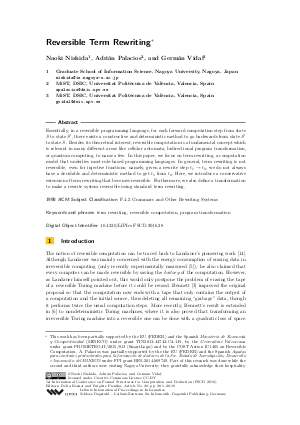Reversible Term Rewriting
Authors Naoki Nishida, Adrián Palacios, Germán Vidal
-
Part of:
Volume:
1st International Conference on Formal Structures for Computation and Deduction (FSCD 2016)
Part of: Series: Leibniz International Proceedings in Informatics (LIPIcs)
Part of: Conference: Formal Structures for Computation and Deduction (FSCD) - License:
 Creative Commons Attribution 3.0 Unported license
Creative Commons Attribution 3.0 Unported license
- Publication Date: 2016-06-17
File

PDF
LIPIcs.FSCD.2016.28.pdf
- Filesize: 0.56 MB
- 18 pages
Document Identifiers
Subject Classification
Keywords
- term rewriting
- reversible computation
- program transformation
Metrics
- Access Statistics
-
Total Accesses (updated on a weekly basis)
0PDF Downloads0Metadata Views
Abstract
Essentially, in a reversible programming language, for each forward computation step from state S to state S', there exists a constructive and deterministic method to go backwards from state S' to state S. Besides its theoretical interest, reversible computation is a fundamental concept which is relevant in many different areas like cellular automata, bidirectional program transformation, or quantum computing, to name a few. In this paper, we focus on term rewriting, a computation model that underlies most rule-based programming languages. In general, term rewriting is not reversible, even for injective functions; namely, given a rewrite step t1 -> t2, we do not always have a decidable and deterministic method to get t1 from t2. Here, we introduce a conservative extension of term rewriting that becomes reversible. Furthermore, we also define a transformation to make a rewrite system reversible using standard term rewriting.
Cite As Get BibTex
Naoki Nishida, Adrián Palacios, and Germán Vidal. Reversible Term Rewriting. In 1st International Conference on Formal Structures for Computation and Deduction (FSCD 2016). Leibniz International Proceedings in Informatics (LIPIcs), Volume 52, pp. 28:1-28:18, Schloss Dagstuhl – Leibniz-Zentrum für Informatik (2016)
https://doi.org/10.4230/LIPIcs.FSCD.2016.28
BibTex
@InProceedings{nishida_et_al:LIPIcs.FSCD.2016.28,
author = {Nishida, Naoki and Palacios, Adri\'{a}n and Vidal, Germ\'{a}n},
title = {{Reversible Term Rewriting}},
booktitle = {1st International Conference on Formal Structures for Computation and Deduction (FSCD 2016)},
pages = {28:1--28:18},
series = {Leibniz International Proceedings in Informatics (LIPIcs)},
ISBN = {978-3-95977-010-1},
ISSN = {1868-8969},
year = {2016},
volume = {52},
editor = {Kesner, Delia and Pientka, Brigitte},
publisher = {Schloss Dagstuhl -- Leibniz-Zentrum f{\"u}r Informatik},
address = {Dagstuhl, Germany},
URL = {https://drops.dagstuhl.de/entities/document/10.4230/LIPIcs.FSCD.2016.28},
URN = {urn:nbn:de:0030-drops-59841},
doi = {10.4230/LIPIcs.FSCD.2016.28},
annote = {Keywords: term rewriting, reversible computation, program transformation}
}
